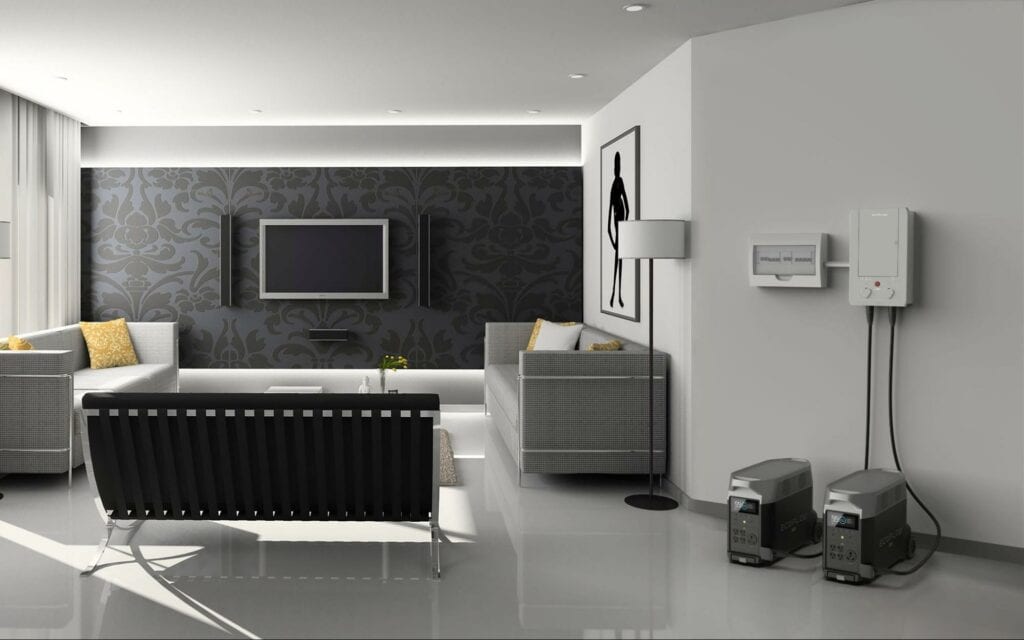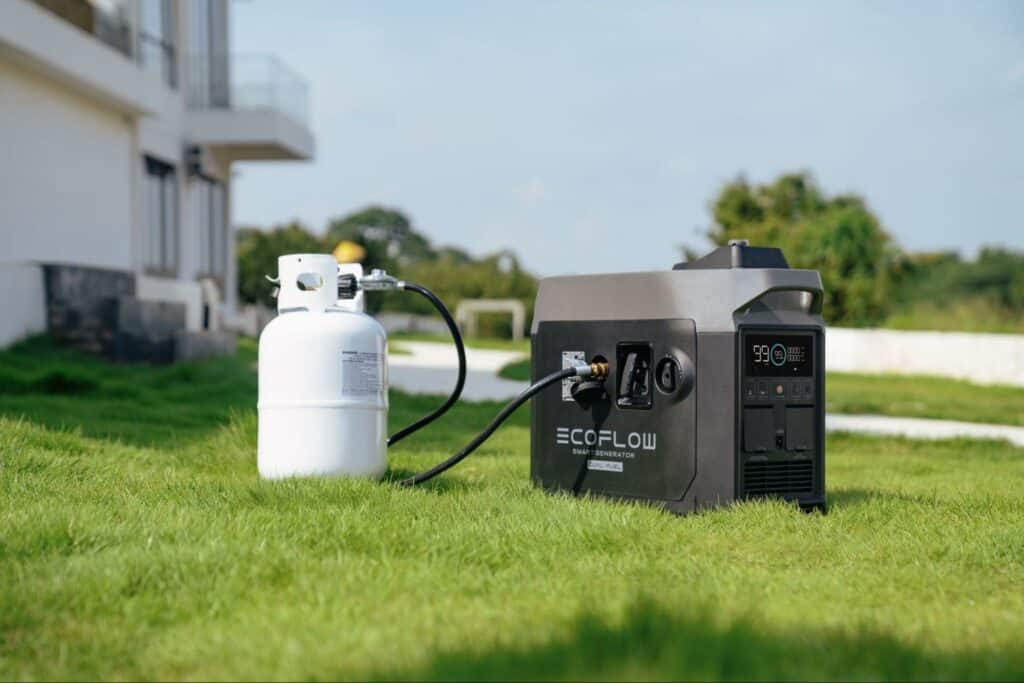Table of Contents
A power inverter is an electrical component that converts direct current (DC) to alternating current (AC).
Inverters are an essential part of many electronic devices and systems, from smartphones and EVs to solar generators and battery backup solutions.
Photovoltaic modules like solar panels produce DC electricity. Batteries store electricity as direct current.
For the power generated by PV modules and stored by batteries to be consumed, an inverter must change DC into AC (household) electricity.
How Does an Inverter Work?
Inverters fall into three categories.
Electronic
Electronic inverters are by far the most commonplace. An electronic inverter uses power transistors or other semiconductors to switch DC input on and off at an extremely fast rate to create AC output.
There are numerous types of AC electricity classified by the shape of a current’s waveform. Waveforms offer “a visual representation of the variation of a voltage or current plotted to a base of time.”
AC Waveforms
(Source: Electronics Tutorials)
There are virtually endless variations of AC waveforms, but the most desirable for most applications is sine wave (or true sine wave) alternating current.
For example, the power inverter built into EcoFlow’s DELTA Series of portable power stations provides pure sine wave AC output instead of noisier, dirtier modified sine waves.
A pure sine wave output is desirable as it puts less stress on the components of sensitive electronic devices.
Mechanical
A mechanical inverter utilises a rotary device, such as a motor, a transformer, and an electromagnetic switch, to an alternate direct current back and forth between the primary winding of a circuit, creating a rudimentary alternating current output.
Mechanical inverters are rarely used nowadays. Solid-state (electronic) inverters have made them obsolete by producing much cleaner power with no moving parts.
One type of mechanical inverter that remains in specialised use is the rotary phase converter. A rotary phase converter is used to convert single-phase into three-phase electricity.
Converting single-phase power to three-phase is only required in industrial applications.
Static
Static inverters are used in specialised applications that require uninterrupted power, such as emergency lighting systems.
Static inverters are often used in uninterruptible power supply (UPS) devices to protect sensitive electronic equipment like servers and hard drives.
What Are the Applications of Inverters?
Power inverters are virtually ubiquitous in modern electronics, particularly in devices that are battery-operated.
Batteries store DC electricity, which must be converted to AC to operate most devices. Conversely, anything battery-powered that you plug into a wall socket must convert AC to DC electricity to recharge the battery.
Portable rechargeable devices — like smartphones and laptops — have inverters built-in. They’re essential for electronics to function, but you rarely (if ever) need to think about them.
On the other hand, some applications require standalone inverters.
Here are the most common applications where an inverter may not be built in.
Solar Power
Solar panels and other PV modules produce DC electricity by harnessing photons from sunlight using the photovoltaic effect.
However, your home and the utility grid use alternating current (AC), also known as household electricity.
In residential on-grid solar power systems, a solar inverter converts DC to AC electricity for use in your home and transmission back to the utility grid.
In off-grid and hybrid solar systems, inverters convert electricity from AC to DC (and back again) for storage in solar batteries and household use.
Like solar panels, solar batteries use DC power. Depending on the system, a storage inverter may also be required to convert DC to AC for consumption and back to DC for storage.
Every residential photovoltaic system requires a solar inverter. Often, it will be a separate component.
EcoFlow solar generators have high-efficiency inverters built-in, making for greater portability and eliminating cross-compatibility issues that may arise when using components from different manufacturers.
However, whole home battery backup solutions like EcoFlow DELTA Pro Ultra require three separate components:
- Solar panels
- Inverter
- Solar Battery
Except in specialised PV modules with microinverters, the inverter is always separate from the solar panels. Separating the inverter and battery in high-wattage applications like whole-home backup allows for greater modularity and scalability.
Fully maxed out, EcoFlow DELTA Pro Ultra chains together 3 x DELTA Pro Ultra Inverters and 15 x DELTA Pro Ultra Batteries to provide:
- AC Output: 21.6kW
- Storage Capacity: 90kWh
- Solar Charge Capacity: 16.8kW with 3 inverters and 42 x 400W Rigid Solar Panels

Home Backup Batteries
Home backup battery solutions are ideal if you want energy security but live in a home that’s not suitable for solar panel installation.
If you don’t have an area on your property that receives direct sunlight, photovoltaic modules are not a viable option.
But that doesn’t mean you can’t benefit from the combination of home backup batteries and an inverter.
EcoFlow DELTA Pro does offer solar charging, but thanks to its proprietary inverter and LiFePO4 battery technology, you can also recharge in other ways.
- AC input
- DC (Car charging) input
- EV charging station
- EcoFlow Smart Home Panel
- EcoFlow Smart Generator (Dual Fuel)
As part of the EcoFlow Smart Home Ecosystem, DELTA Pro is expandable to 25kWh of battery storage — enough to run most homes for a week during a power outage.
Integrate EcoFlow DELTA Pro’s inverter and LFP battery with your home’s existing circuitry with the EcoFlow Smart Home Panel for the ultimate in remote monitoring and control.

Inverter Generators
Inverter generators are a more energy-efficient alternative to traditional fossil fuel generators that run on petrol or propane.
Unlike a traditional generator, inverter generators automatically throttle up and down based on electricity demand instead of constantly running at full tilt.
Consequently, inverter generators burn less fossil fuel to deliver the same amount of electricity — especially when you’re only operating a few devices with genny power.
Inverter generators are more expensive than traditional models. But over the long term, you’ll save significantly on fuel costs and do less damage to the environment. EcoFlow Smart Generator (Dual Fuel) alternates between propane and petrol to give you more flexibility than with only one fuel source.
Not only are inverter generators cleaner, but they’re also less noisy. The built-in muffler dampens noise output down to as low as 56 decibels.
Electric Vehicles
It goes without saying that you don’t have to purchase a separate inverter for your EV.
However, it is a discrete and essential component for utilising the vehicle’s battery.
The lithium-ion or lithium iron phosphate (LiFePO4/LFP) batteries in EVs store DC power. Home EV chargers use AC power.
Without a built-in inverter, you wouldn’t be able to charge your car using the utility grid.
Inverter Air Conditioners
Similar to inverter generators, inverter air conditioners use smart technology to control the speed of the compressor based on ambient temperature.
Instead of only operating at full blast, inverter air conditioners use the minimum amount of electricity to achieve your desired temperature.
Variable cooling speeds lead to greater efficiency and energy savings.
One example of an innovative inverter air conditioner solution is EcoFlow WAVE 2. It’s portable enough to move to any room in your home — you can even take it with you on the road to cool you down or heat you up.
EcoFlow Wave 2’s proprietary inverter compressor cools (5100 BTUs) and heats (6100 BTUs), taking your room or motorhome from chilly to cosy in just 5 minutes.
Enjoy 8 hours of quiet comfort in Sleep Mode with an operating noise level of just 44 dB.
Final Thoughts
You might take it for granted, but the humble inverter is an essential component of many of the modern electrical devices you enjoy every day.
If you’re reading this on your phone or laptop, you’re using one right now!
As the leading manufacturer of portable power stations and solar generators, EcoFlow has long been at the cutting edge of advanced battery technology. Inverters are an integral part of virtually everything we make.
If you’d like to see what next-level solar inverter and LFP battery systems can do, check out DELTA Pro Ultra today.







